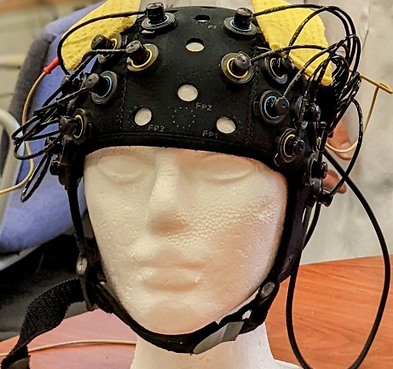Highlights:
Issue 8 - August 2025
Issue 3 Article 6
Recharging the Mind: Transcranial Direct-Current Stimulation (tDCS)
and its Role in Rehabilitative Care
25/3/20
By:
Gu Hao Gen
Edited:
Crystal Tay Yuan Ying
Tag:
Biotechnology and Engineering

For centuries, humans have experimented with electricity to heal the body – from ancient Egyptians using electric fish to treat pain, to 19th-century scientists jolting the brain with electric shocks in search of hidden treasures. Today, transcranial direct-current stimulation (tDCS) has refined these early concepts by delivering precise, low-intensity currents designed to enhance mental health, boost cognitive function, and aid in neurological recovery. But how exactly does this cutting-edge therapy work, and have scientists pushed it to its max?
Who needs tDCS and why do they need it?
Imagine a patient who has just suffered a stroke and is on course for neurological rehabilitation. Simple movements feel impossible to him; he speaks sluggishly, and is unable to extend his limbs on command. His frustration grows with every failed attempt to regain motor control, until doctors introduce transcranial direct-current stimulation (tDCS).
Of course, weakened motor control is just one of the range of symptoms that tDCS aims to alleviate. Other symptoms include memory deficits, mood disturbance and even cognitive challenges. tDCS is commonly targeted at patients suffering from various neurological disorders like Parkinson's disease, stroke recovery, and multiple sclerosis. tDCS aims to alleviate these symptoms by modulating brain activity to improve overall cognitive and emotional well-being.
How does the brain work, and what are neural oscillations?
The brain functions through complex networks of neurons, which are specialized cells that transmit electrical signals. These signals enable communication between different parts of the brain, allowing for thoughts, movements, and sensory processing. Neurons work by generating electrical impulses, which travel along their axons to communicate with other neurons across synapses. Neural oscillations, or brain waves, are rhythmic patterns of neural activity that reflect the coordinated firing of neurons. These oscillations occur at different frequencies, and each frequency range is associated with different cognitive and behavioral states.
How does tDCS work?
Seated in a quiet therapy room in front of a laptop, the patient wears a cap fitted with electrodes targeting specific brain regions. Conductive gel is applied through small pockets on the cap. As the device delivers a gentle current, the patient feels a faint tingling sensation. tDCS employs a low-intensity direct current (typically 0.5–2 mA), delivered through one or more active electrodes (anode). The current flows through the scalp, with the reference electrode (cathode) completing the circuit. This unidirectional flow of electricity effectively modulates cortical excitability (Nitsche and Paulus, 2000), typically enhancing excitability at the anodal site (Boros et al., 2008) and reducing it at the cathodal site (Ardolino et al., 2005).
Whilst a large amount of the current is conducted between electrodes through soft tissue and skull (Vöröslakos et al. 2018), a portion of the current penetrates the scalp and is conducted through the brain, where the system can alter neuronal excitability – which refers to the response of the neuron to stimulation. With increased neuronal excitability, the patient’s neurons are able to transmit electrical impulses from the hypothalamus to effector organs, thereby improving motor control and cognitive ability.
How do therapists monitor the effectiveness of tDCS rehabilitation?
tDCS is currently being trialled in Singapore, in hospitals such as Ang Mo Kio Thye Hua Kwan Hospital. Using the same cap fitted with electrodes, the hospital’s patients play a simple game to improve motor control and cognitive ability, just that this time – electrotherapy patches are pasted on their arm.
Before the patient, a piece of cheese is seen on a table in the digital interface. A rat scurries toward it, and the patient – based on instinct – must raise his hand to shoo it away. However, if weakened neurons delay his reaction, the rat reaches the cheese first, and the electrotherapy patch will deliver a momentary low-intensity current – as a punishment!
On the other hand, therapists are provided with a detailed chart of the patient’s brain activity throughout the game. Interpreting the chart could be in the form of analysing heightened neuronal excitability when the patient sees the rat. Using this, therapists are able to conclude the effect of tDCS on the patient, and discuss whether to continue this form of rehabilitation.
Conclusion
Feeling numb at the knees just by hearing the idea of an electrical current penetrating your scalp? Well, think again. Transcranial direct-current stimulation (tDCS) offers a promising, non-invasive approach to treating neurological and psychological conditions, with potential benefits in rehabilitation, motor control, and cognitive enhancement. Indeed, tDCS has the potential to become a key component of personalized therapies, improving patients' quality of life and brain health.
References
Latest News




